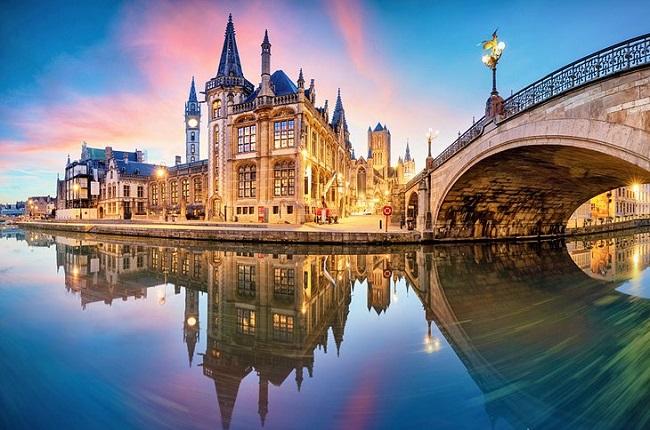Belgium may be a small country, but it is mighty in attractions, brimming with historic architecture, world-class art, and a culinary tradition that’s hard to beat. From medieval towns to modern cities, Belgium offers a travel experience that combines the best of culture, history, and indulgence.
This article takes you through the top 10 most visited places in Belgium, each offering a unique slice of Belgian life that promises to enchant every traveler.

Top 10 Most Visited Places in Belgium
1: Brussels:
The heart of the European Union, Brussels is known for its Grand Place with ornate baroque and gothic guildhalls, the iconic Atomium, and the Manneken Pis statue. The city is a melting pot of cultures, offering a vibrant art scene and diverse culinary experiences.
2: Bruges:
Often referred to as the Venice of the North, Bruges is famed for its medieval architecture, picturesque canals, and cobblestone streets. The Belfry of Bruges and the Historium offer a dive into the city’s rich history.
3: Antwerp:
Antwerp is a fashion hub and the world’s diamond trading center. The city’s stunning cathedral, historic zoo, and the Rubens House museum, showcasing the works of the famous painter, make it a must-visit.
4: Ghent:
With its well-preserved medieval architecture, Ghent is less crowded than Bruges but equally charming. Highlights include Saint Bavo’s Cathedral and the Gravensteen castle.
5: Leuven:
A vibrant university town, Leuven boasts the oldest Catholic university in the world, beautiful Gothic buildings like the Town Hall, and a lively nightlife scene thanks to its student population.
6: Liege:
Known for its vibrant local life, Liege’s attractions include the Prince-Bishops’ Palace, the Curtius Museum, and the Montagne de Bueren, a staircase with stunning views of the city.
7: Tournai:
One of the oldest cities in Belgium, Tournai has a remarkable cathedral with five towers, the Pont des Trous bridge, and a rich artistic history, having been home to the painter Rogier van der Weyden.
8: Dinant:
This small town is nestled along the Meuse River and is renowned for its cliff-top citadel, the Collegiate Church of Notre Dame, and its association with the inventor of the saxophone, Adolphe Sax.
9: Ypres:
An important site during World War I, Ypres today is known for the Menin Gate Memorial, the In Flanders Fields Museum, and its moving Last Post ceremony, which honors the fallen of the Great War.
10: Ardennes:
For those seeking outdoor adventures, the Ardennes region offers dense forests, caves, and hills that are perfect for hiking, kayaking, and exploring Belgium’s natural beauty.
Conclusion:
Belgium’s top 10 most visited places are as diverse as they are fascinating, offering insights into the country’s rich tapestry of history, culture, and gastronomy.
Whether indulging in the finest chocolates, exploring ancient castles, or enjoying the lively atmosphere of a local pub, visitors to Belgium are sure to leave with memories of a lifetime.
This small European nation, with its friendly locals and easy-to-navigate cities, invites you to discover its hidden gems and popular hotspots alike.
FAQ: Top 10 Most Visited Places in Belgium
Q1: What is the best time to visit Belgium?
A1: The best time to visit Belgium is from April to June or September to October when the weather is mild, and there are fewer tourists. July and August are warmer but can be crowded due to the summer holidays.
Q2: Do I need a visa to visit Belgium?
A2: Belgium is part of the Schengen Area. Visitors from Schengen countries can travel freely without a visa. Tourists from certain countries outside the Schengen Area can enter without a visa for stays of up to 90 days.
It’s important to check the latest visa requirements from the Belgian embassy or consulate before traveling.
Q3: What are the must-try foods in Belgium?
A3: Belgian cuisine is known for its quality and variety. Some must-try foods include Belgian chocolates, waffles, fries with mayonnaise, moules-frites (mussels with fries), and a wide range of Belgian beers.
Q4: What is the currency in Belgium?
A4: The currency used in Belgium is the Euro (€). Credit cards are widely accepted, and ATMs are readily available, but it’s always a good idea to carry some cash for small purchases, especially in rural areas or at small businesses.
Q5: How do I get around in Belgium?
A5: Belgium has an excellent public transportation system, including trains, trams, and buses, which are efficient ways to travel around the country. The train network connects all major cities and many tourist attractions.
Q6: What is the tipping etiquette in Belgium?
A6: Service is usually included in the bill in Belgium, so tipping is not obligatory. However, it is customary to round up to the nearest euro or leave a small tip (5-10%) for good service in restaurants.
Q7: Can I drink tap water in Belgium?
A7: Yes, tap water in Belgium is safe to drink. However, many locals prefer bottled water due to the taste of the tap water in some areas.
Q8: What should I pack for a trip to Belgium?
A8: It’s a good idea to pack for changeable weather, including a waterproof jacket and layers that can be easily added or removed. Comfortable walking shoes are also recommended, as you’ll likely do a lot of walking while sightseeing.
Q9: What electrical plug is used in Belgium?
A9: Belgium uses the Type E power socket, and the standard voltage is 230V. Travelers from countries with different socket types should bring a power adapter.
Q10: Are the tourist sites in Belgium accessible for visitors with disabilities?
A10: Many tourist attractions and public transport options in Belgium are accessible to visitors with disabilities. However, some of the historic buildings may have limited accessibility due to their age.
It’s best to check with individual attractions in advance regarding their facilities.


















































